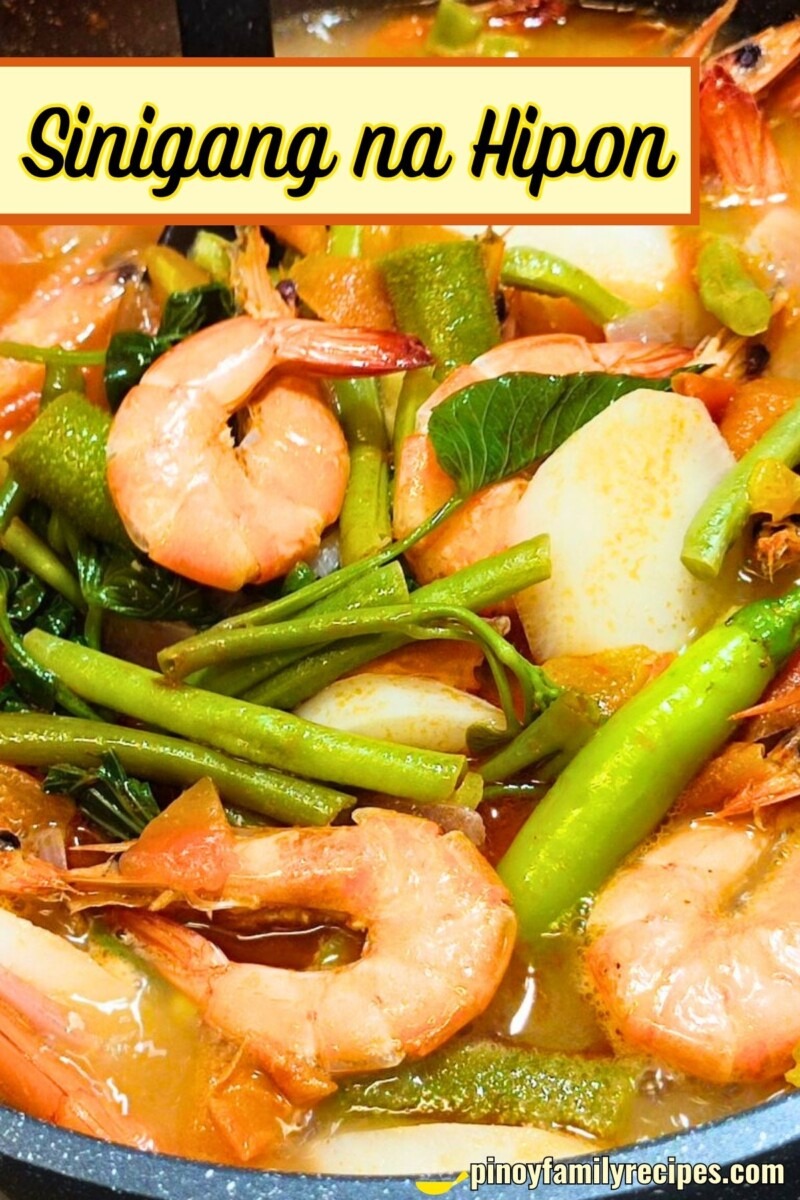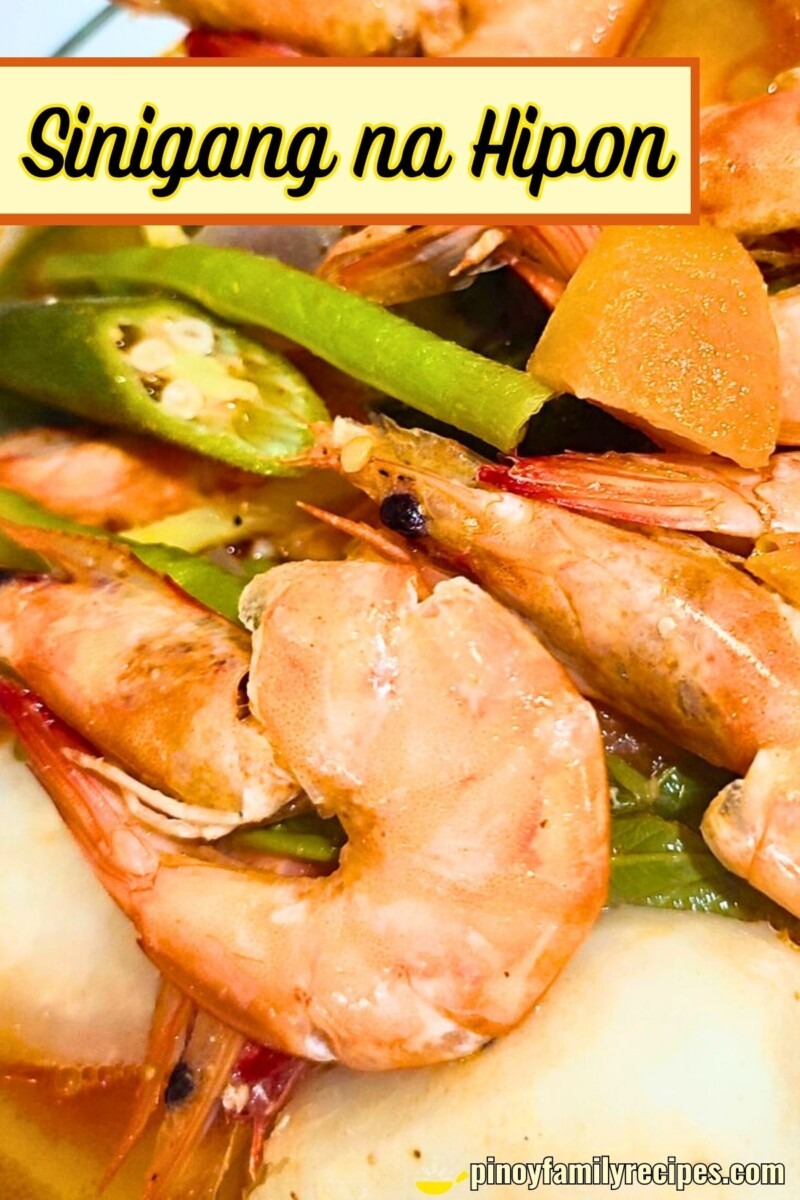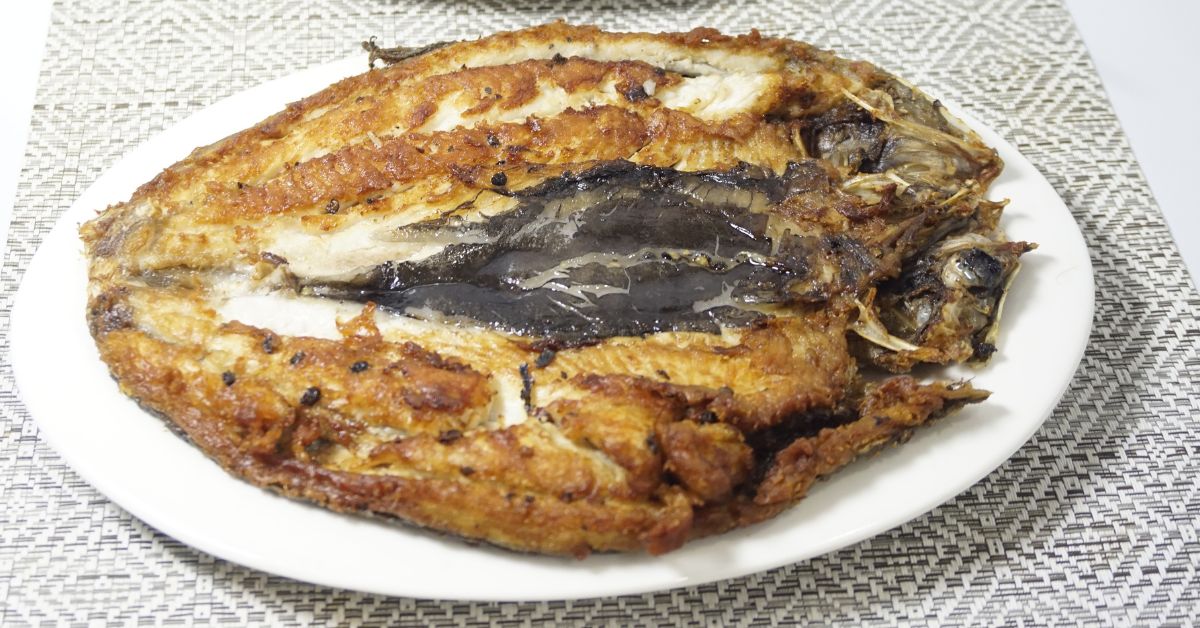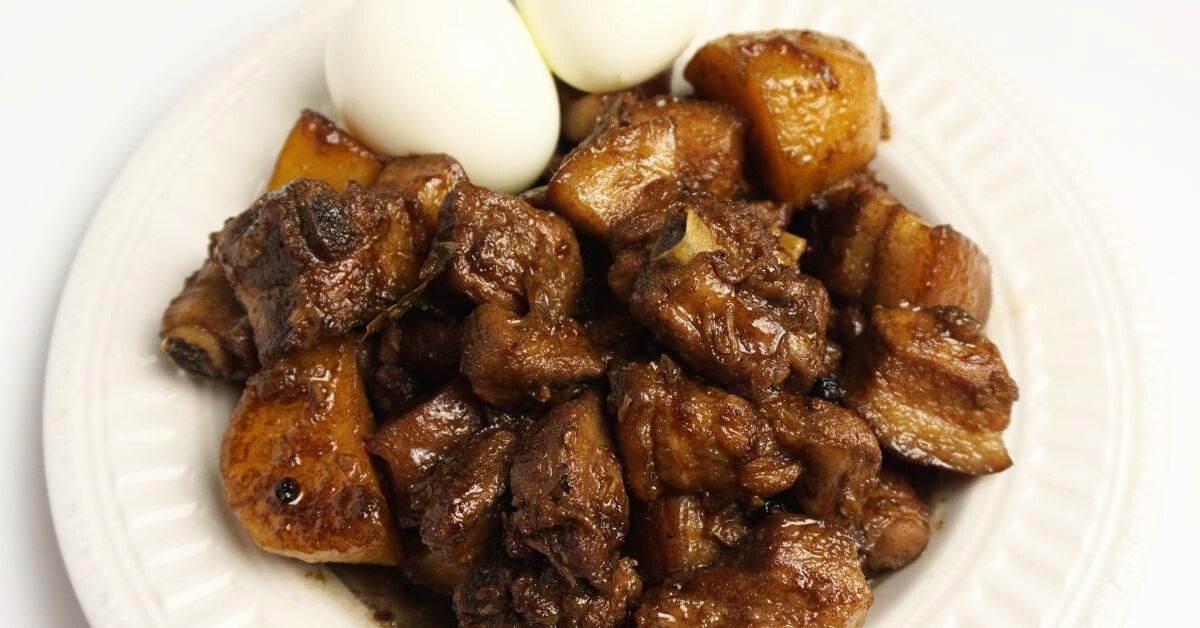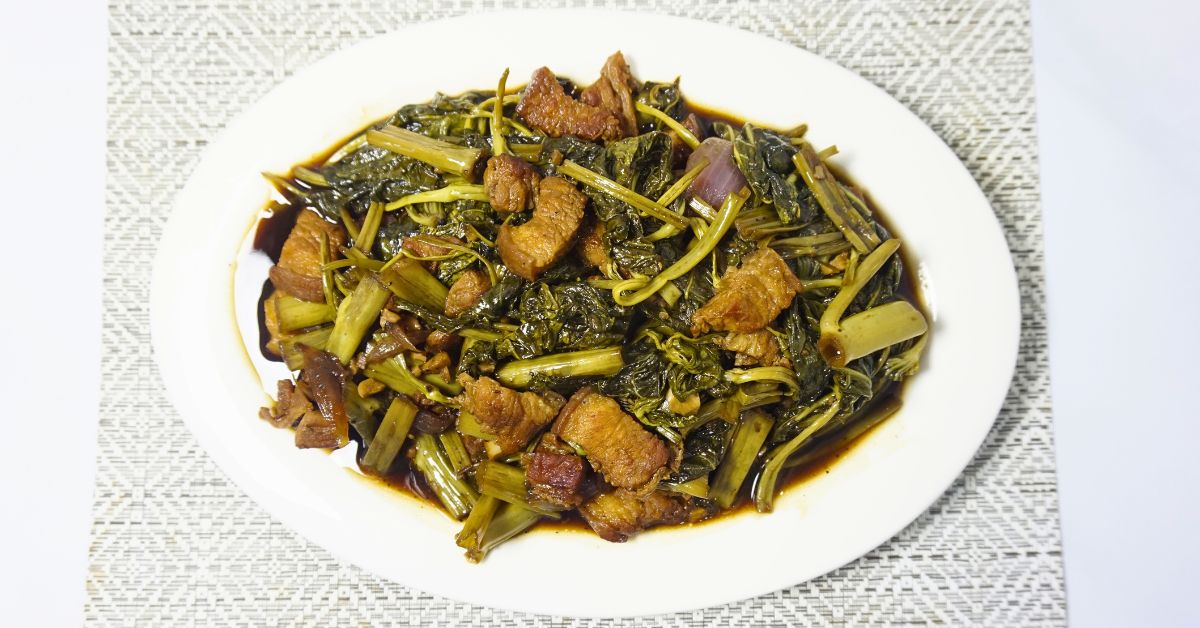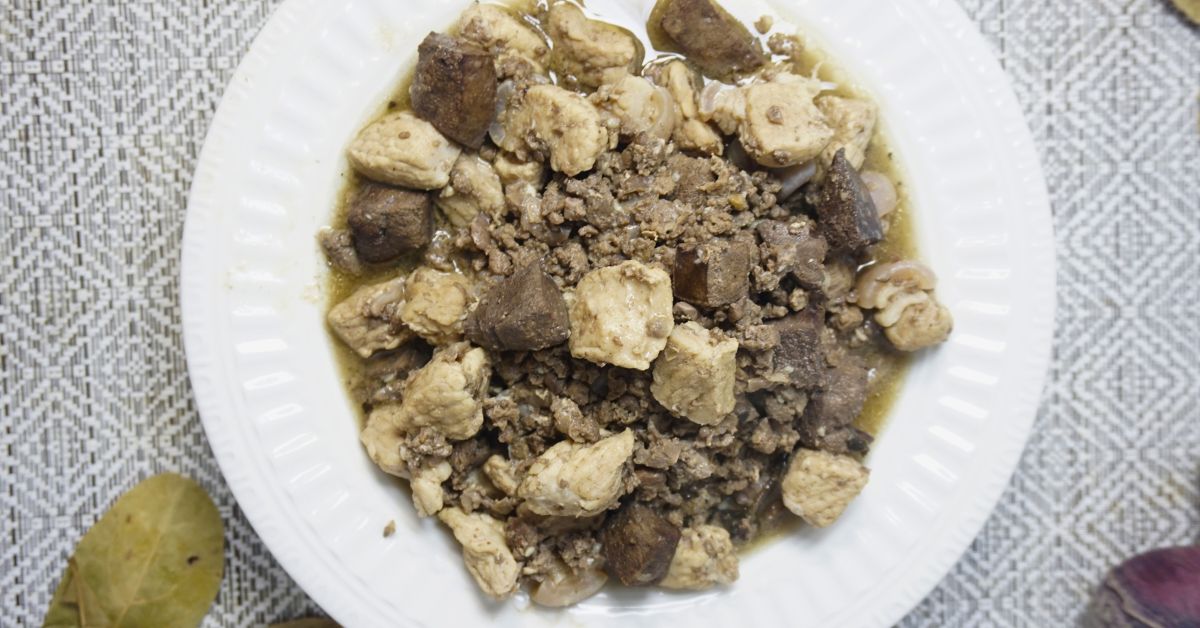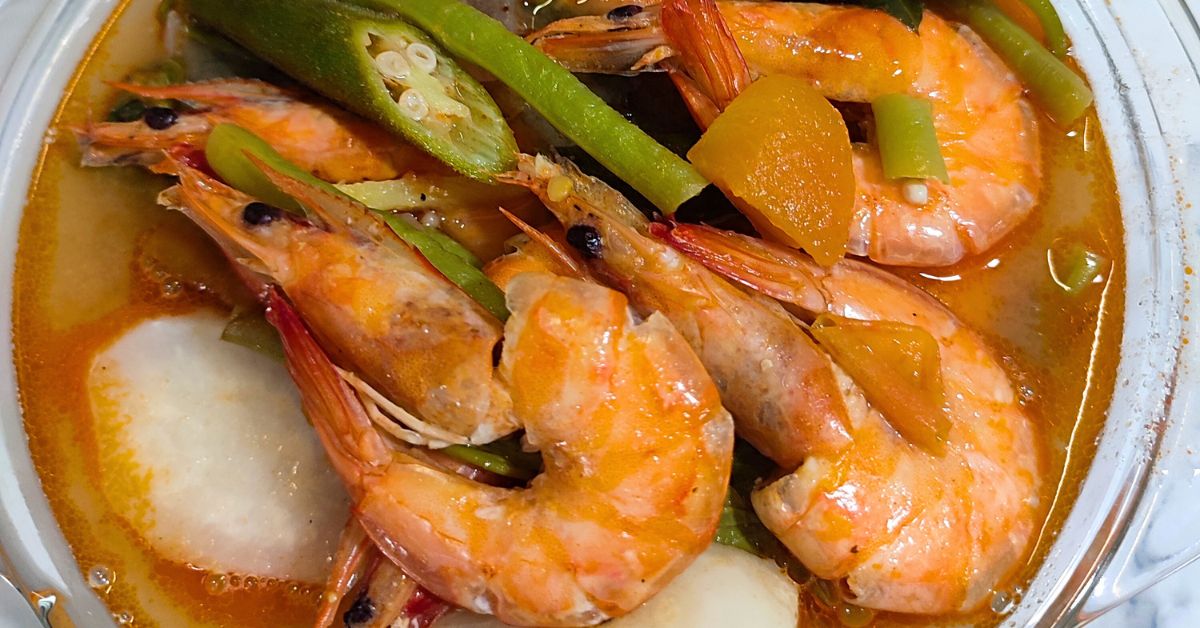
Sinigang na Hipon is one of those dishes that just hits the spot, especially on gloomy rainy days here in the Philippines. It’s a tangy shrimp soup that instantly warms you up.
Just like Sinigang na Baboy, this comforting bowl brings back a lot of good memories. Imagine juicy shrimp swimming in a sour broth. Every spoonful feels like a warm cozy hug.
I used to ask for this every time it rained. Shrimp wasn’t something we had often, so whenever Mom made Sinigang na Hipon, it felt like a treat. I can still remember the smell filling our kitchen and hearing the rain outside. It made the whole experience feel extra special.
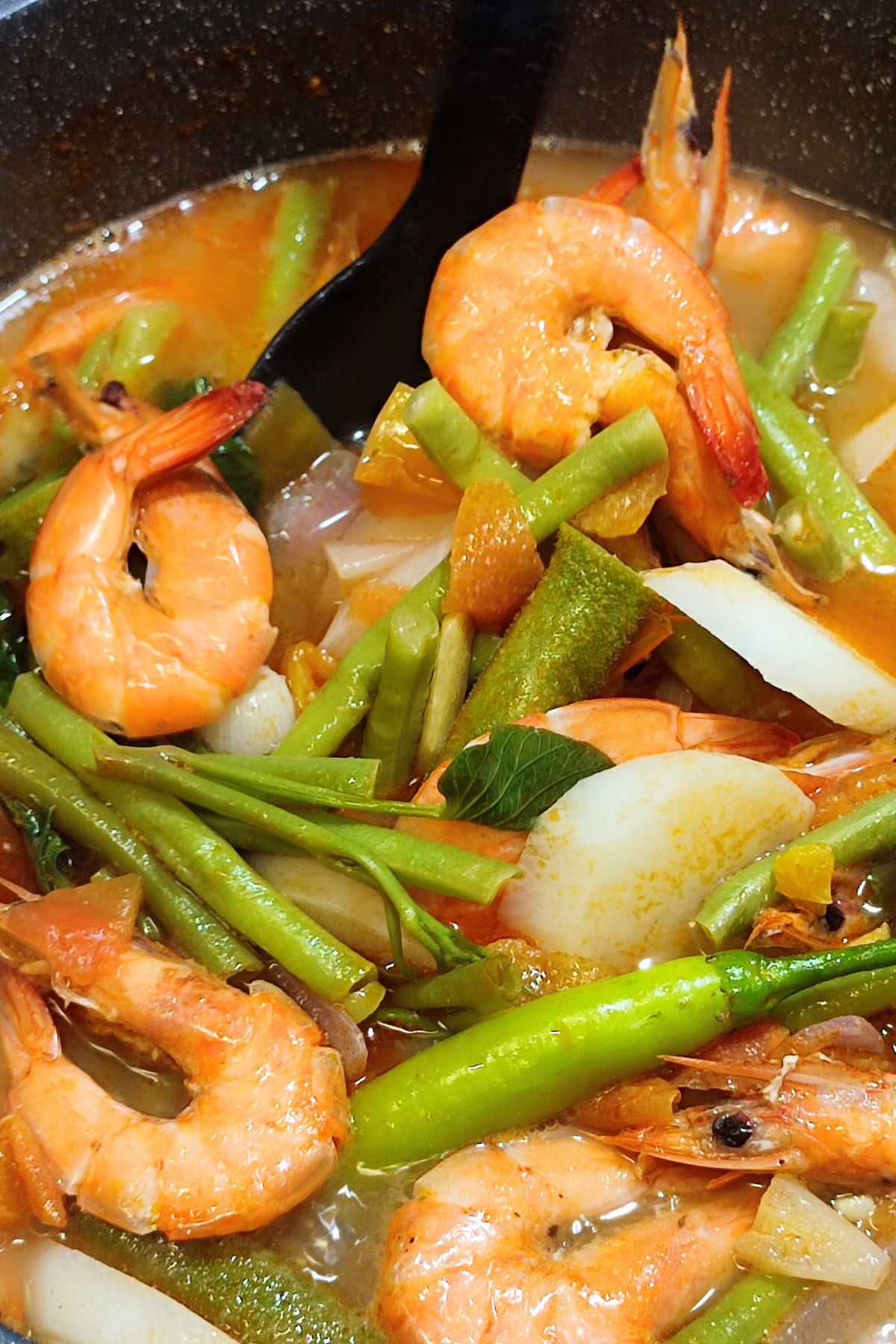
Sinigang na Hipon Ingredients
Cooking Oil
Used for sautéing, cooking oil helps bring out the flavors of the ginger, onion, and tomatoes. It sets the base for the delicious aroma and taste of the soup.
Ginger
Sliced into thumb-sized pieces, ginger adds a warm, zesty kick. It gives the broth that extra depth and a hint of spice.
Onion
A medium onion, sliced, adds a natural sweetness and savory flavor that blends perfectly with the other ingredients.
Tomatoes
Sliced medium tomatoes bring a bit of tang and sweetness. They help balance the sourness of the soup while adding color and flavor.
Gabi (Taro)
Gabi softens as it cooks, giving the soup a slightly thick and creamy texture. It makes every spoonful extra comforting.
Shrimp
Cleaned and deveined shrimp are the star of the dish. They cook quickly and add a naturally sweet seafood flavor to the broth.
String Beans
Cut into 3-inch pieces, string beans add a bit of crunch and freshness. They also give the soup a nice pop of green.
Water
This is the base of the soup, helping all the ingredients come together into one flavorful bowl.
Okra
Trimmed and halved, okra adds a slightly earthy taste and helps thicken the broth a little. It goes well with the other veggies.
Radish (Labanos)
Sliced radish brings a mild peppery flavor and a crisp bite. It balances out the rich and sour notes in the soup.
Sinigang Mix
This is where the signature asim comes from. It’s a quick and easy way to get that traditional sinigang flavor.
Tip: If you have sampaloc sitting around in your pantry, you can use it as a natural souring agent. Just boil it until soft, mash it to release the juice, then strain. It gives your sinigang a more authentic and fresh sourness that’s hard to beat.
Kangkong (Water Spinach)
Cut into 3-inch pieces, kangkong leaves are soft and mild with a hint of sweetness. They cook fast and round out the soup with a fresh green finish.
Green Chili
A single green chili gives the soup a gentle heat. It adds just enough spice to warm up the flavor without making it too spicy.
Salt and Pepper
These are for seasoning and balancing the taste. Add them to suit your preference.
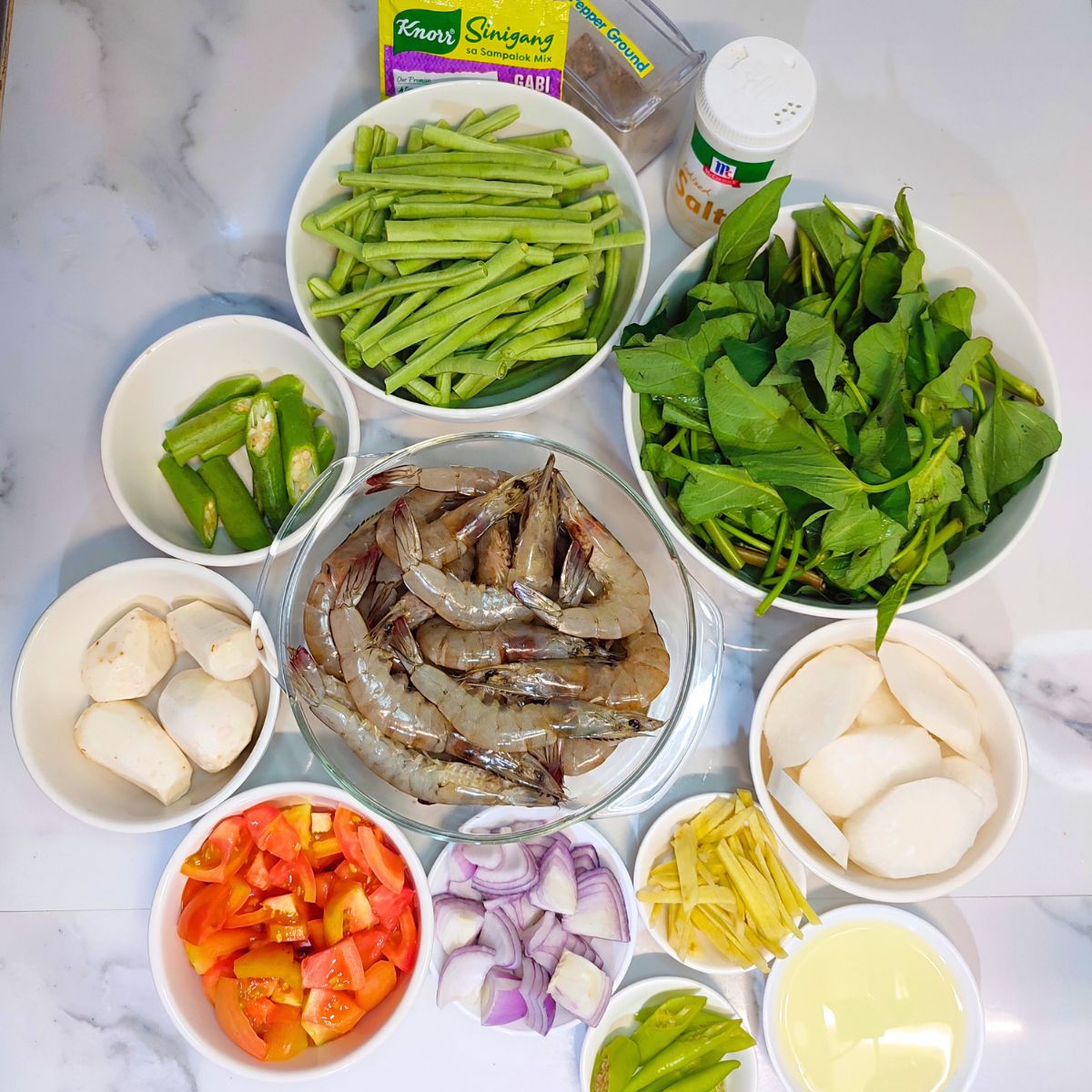
How To Cook Sinigang na Hipon
Disclaimer: In this recipe, I chose to sauté the ingredients first to help reduce the fishy smell (malansa) and bring out more flavor from the ginger, onion, and tomatoes. It gives the soup a cleaner taste and a richer aroma.
But of course, you can skip this step if you prefer. You can simply boil everything—starting with the harder ingredients like gabi and radish—then add the rest as you go. Both methods work, so just go with what’s easier or what you’re used to.
Prepare the Ingredients
- Clean the shrimp. Remove the veins for a cleaner taste.
- Cut the okra into bite-sized pieces.
- Wash the Kangkong leaves thoroughly.
- Slice the tomato and snake beans.
- Peel and slice the ginger and onion.
Sauté the Aromatics
Heat the cooking oil in a large pot over medium heat. Add the sliced ginger, onion, and tomatoes. Sauté until the onions are translucent and the tomatoes soften. Then, add the gabi (taro) pieces. This step creates a tasty base for your Sinigang na Hipon.
Cook the Shrimp and String Beans
Add the cleaned and deveined shrimp along with the string beans. Cook until the shrimp turn pink and opaque, about 3-5 minutes. Add salt and pepper, and toss to mix. The shrimp will add a sweet flavor, while the string beans give a nice crunch.
Add Water and Vegetables
Pour in 8 cups of water. Add the okra and radish, then bring the mixture to a boil. This step turns the sautéed ingredients into a soup, blending all the flavors together.
Incorporate the Sinigang Mix
Once the soup is boiling, stir in the sinigang mix until it is fully dissolved. This mix gives the soup its traditional sour and savory taste.
Add the Greens and Final Touches
Add the kangkong leaves and a green chili. Cook for another 1-2 minutes, just until the greens are wilted. The kangkong leaves add a fresh flavor, and the green chili gives a bit of heat.
Final Adjustments and Serving
Taste the soup and adjust the seasoning if needed. Serve it hot with steamed rice. Enjoy this comforting and flavorful dish with your family and friends!
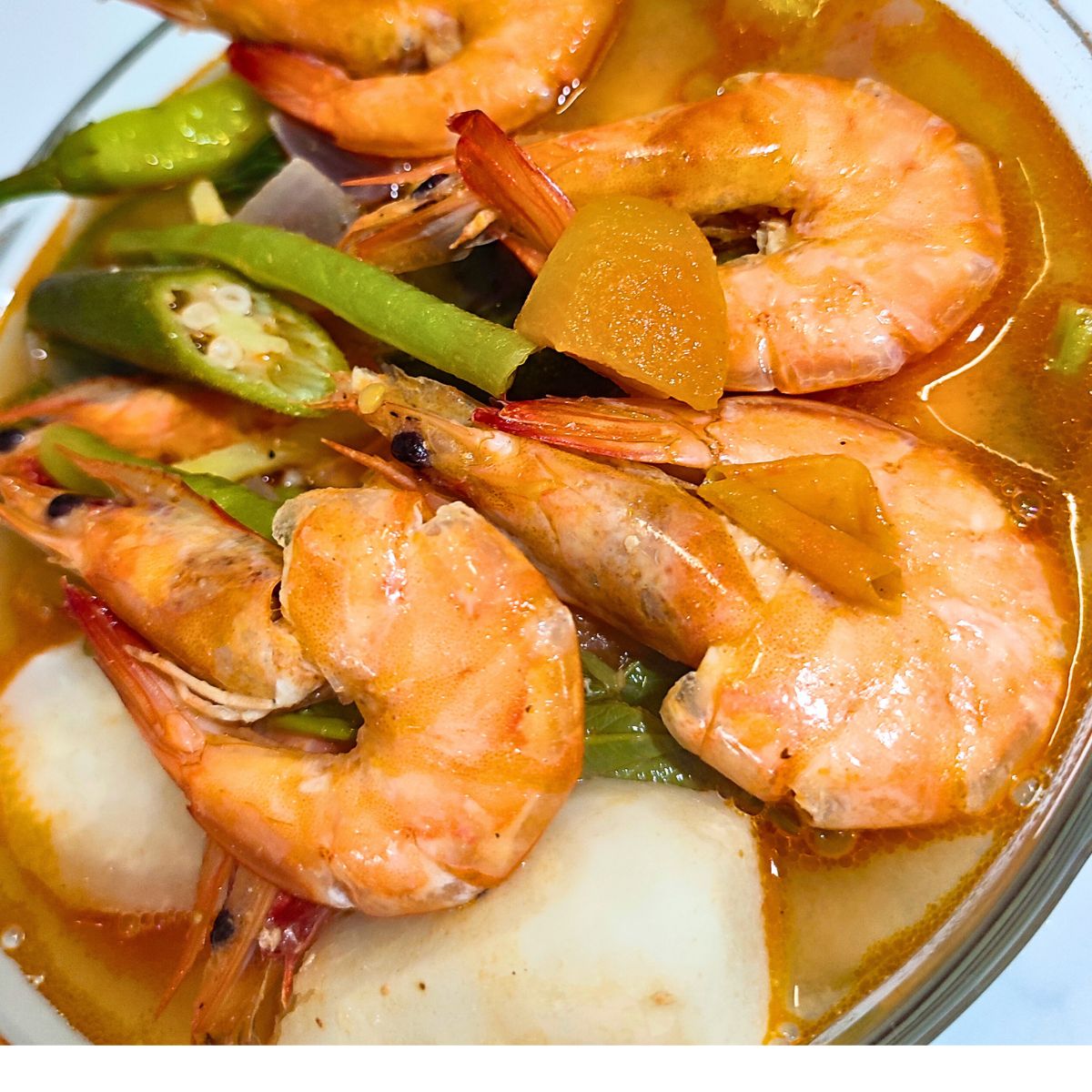
Tips on How To Cook a Perfect Sinigang na Hipon
Cooking a perfect Sinigang na Hipon is a delightful journey, and here are some tips to ensure your dish turns out just right:
Choose Fresh Shrimp
Opt for fresh shrimp with a bright color and firm texture. This ensures a sweet and succulent flavor in your Sinigang.
Clean Shrimp Properly
Clean and devein the shrimp thoroughly to remove any sand or unwanted bits. This ensures a clean and enjoyable soup.
Saute Onion, Ginger, and Tomato
Sauteing onion, ginger, and tomato in a bit of oil before adding water brings out rich flavors and helps reduce the fishy taste. It’s a simple step that makes a big difference.
Balance the Tanginess
Adjust the amount of Sinigang Mix based on your preference. Some like it more tangy, while others prefer a milder taste. Start with a moderate amount and add more if needed.
Control the Salt
Be mindful of the salt content, especially if your Sinigang Mix already has some. You can always add more salt later, but it’s challenging to fix an overly salty dish.
Don't Overcook Vegetables
Add the vegetables at the right time to prevent them from becoming mushy. They should be tender but still have a bit of bite.
Experiment with Vegetables
Feel free to experiment with vegetables. While okra, Kangkong leaves, and snake beans are traditional, you can add other veggies like eggplant or water spinach to suit your taste.
Serve Hot with Rice
Sinigang na Hipon is best enjoyed hot and paired with a side of steamed rice. The combination of the tangy soup and rice is simply comforting.
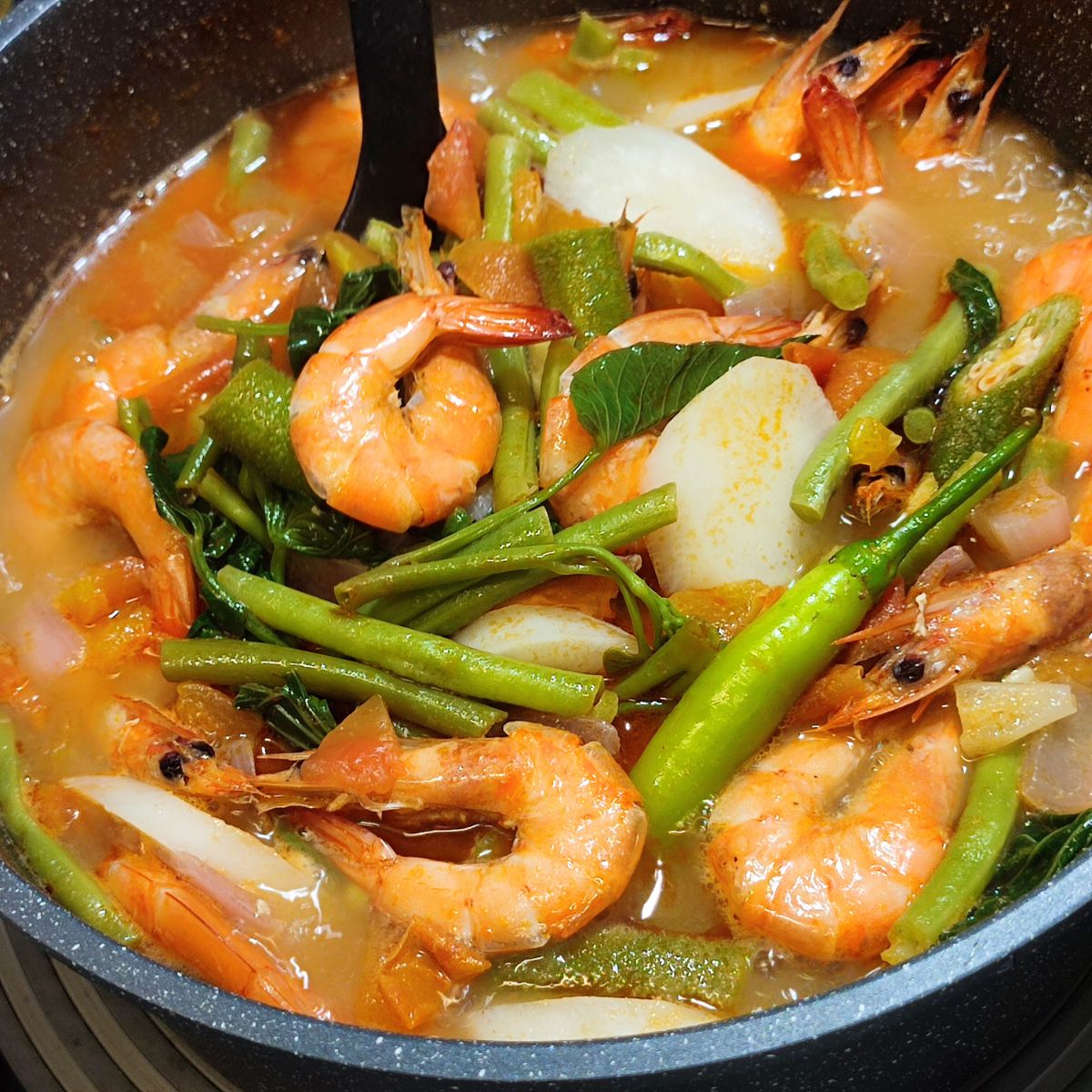
What To Serve With Sinigang na Hipon
Steamed White Rice
Simple and fluffy steamed white rice lets the bold flavors of Sinigang na Hipon stand out, making each bite a comforting delight. Its mild taste plays well with the richness of shrimp and the tangy broth, creating a perfect harmony.
Inihaw na Liempo (Grilled Pork Belly)
Grilled pork belly adds a smoky and savory touch that pairs wonderfully with the tangy Sinigang na Hipon, creating a flavorful contrast. The charred edges and succulent meat make each bite a delicious explosion of tastes.
Pakbet (Filipino Vegetable Stew)
Pakbet, or pinakbet a mix of veggies like eggplant and squash, complements Sinigang na Hipon by bringing hearty flavors and textures. The earthy notes of Pakbet balance the tanginess of Sinigang, creating a satisfying Filipino meal.
Adobong Pusit (Squid Adobo)
Adobong Pusit, or squid adobo, pairs well with Sinigang na Hipon, combining savory adobo sauce with the tanginess for a delightful seafood feast. The tender squid and rich adobo sauce offer a unique seafood twist, capturing the essence of Filipino flavors.
Frequently Asked Questions
Yes, you can substitute shrimp with other seafood like fish (e.g., bangus/milkfish, tilapia), mussels, or squid. The cooking method remains similar, but cooking times may vary slightly depending on the seafood used.
Yes, you can make Sinigang na Hipon spicy by adding more green chili peppers or using a hotter variety of chili. Adjust the spice level according to your preference.
If the soup is too sour, you can dilute it by adding more water or balancing it out with a small amount of sugar or more fish sauce. Adding more vegetables can also help absorb some of the sourness.
Store leftovers in an airtight container in the refrigerator. Sinigang na Hipon can be kept for up to 3 days. When reheating, do so gently on the stove to avoid overcooking the shrimp.

Sinigang na Hipon Recipe
Ingredients
- 2 tbsp Cooking Oil
- 1 piece Ginger thumb-sized (sliced)
- 1 piece Onion medium (sliced)
- 2 pieces Tomatoes medium (sliced)
- 4 pieces Gabi / Taro
- 500 grams Shrimp (cleaned and deveined)
- 150 grams String beans (cut into 3-inch length)
- 8 cups Water
- 200 grams Okra (trimmed and halved)
- 1 piece Radish (Sliced)
- 1 packet Sinigang Mix
- 200 grams Kangkong leaves (cut into 3-inch length)
- 1 piece Green Chili
- Salt and pepper to taste
Instructions
- In a large pot, heat the cooking oil over medium heat. Add the ginger, onion, and tomatoes. Sauté until the onions are translucent and the tomatoes are softened then add the gabi/taro pieces.
- Add the shrimp and string beans,cook until the shrimps turn pink and opaque, about 3-5 minutes. Add salt and pepper then toss.
- Pour in the 8 cups of water. Add the okra and radish and bring to a boil
- Once boiling, stir in the sinigang mix until fully dissolved.
- Add the kangkong leaves and green chili. Cook for another 1-2 minutes or until the greens are wilted.
- Taste and adjust the seasoning if needed. Serve hot with steamed rice.
Watch this!
Notes
- Fresh tamarind or tamarind paste provides the best sour flavor. If unavailable, tamarind soup base (sinigang mix) is a convenient alternative.
